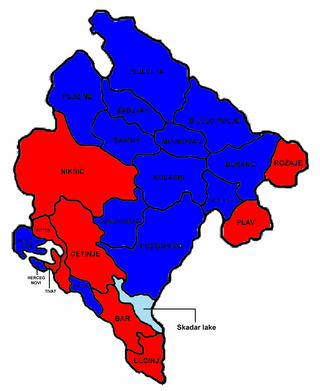
Svetozar Marović is a Montenegrin lawyer and politician who served as the last head of state and head of government of Serbia and Montenegro from 2003 until Montenegro's declaration of independence in 2006.
The Democratic Party of Socialists of Montenegro is a social-democratic and populist political party in Montenegro. A former long-time ruling party sitting at the opposition for the first time as of 2020, it was formed on 22 June 1991 as the successor of the League of Communists of Montenegro, which had governed Montenegro within the Socialist Federal Republic of Yugoslavia since World War II, and has remained a major force in the country ever since. The party is a member of the Socialist International and the Progressive Alliance, and an associate of the Party of European Socialists. During the 1990s, DPS was the major centre-left, social-democratic party in favour of Serbian–Montenegrin unionism. However, since 1997, the party has embraced Montenegrin independence and has been improving ties with the West, slowly turning into a catch-all party embracing Atlanticism, Montenegrin nationalism, neoliberalism, and pro-Europeanism.

The Socialist People's Party of Montenegro is a political party in Montenegro. It is a social-democratic and socially conservative party, that is positioned on the centre-left on the political spectrum with regard to economic matters. It is supportive of accession of Montenegro to the European Union, and was historically supportive of Serbian–Montenegrin unionism.

Milo Đukanović is a Montenegrin politician who served as the President of Montenegro from 2018 to 2023, previously serving in the role from 1998 to 2002. He also served as the Prime Minister of Montenegro and was the long-term president of the Democratic Party of Socialists of Montenegro, originally the Montenegrin branch of the League of Communists of Yugoslavia, which governed Montenegro alone or in a coalition from the introduction of multi-party politics in the early 1990s until its defeat in the 2020 parliamentary election. He is the longest-ruling contemporary politician in Europe, having held key positions in the country for over 33 years. However, he was defeated by the 36-year-old centrist former economy minister, Jakov Milatović, after the presidential run-off held on 2 April 2023.

Momir Bulatović was a Yugoslav and Montenegrin politician. He was the first President of the Republic of Montenegro from 1990 to 1998, after which he served as the Prime Minister of the Federal Republic of Yugoslavia from 1998 until 2000, when Slobodan Milošević was overthrown. He was a leader of the Montenegro's Democratic Party of Socialists from 1989 to 1997, when he split from DPS after a conflict with Milo Đukanović.

Liberal Alliance of Montenegro was a Montenegrin separatist, liberal and anti-war political party, active between 1990 and 2005. The Liberal Alliance was a full member of the Liberal International from 1994 until the party's dissolution in 2005.

The Serb People's Party was a political party in Montenegro.
The European Montenegro was the ruling political alliance in Montenegro headed by Milo Đukanović's Democratic Party of Socialists (DPS).

After a period of political and economic crisis in the 1980s, the constituent republics of the Socialist Federal Republic of Yugoslavia split apart, but the unresolved issues caused a series of inter-ethnic Yugoslav Wars. The wars primarily affected Bosnia and Herzegovina, neighbouring parts of Croatia and, some years later, Kosovo.
Monitor is a weekly news magazine published in Podgorica.

Nezavisni dnevnik Vijesti is a Montenegrin daily newspaper.

Zoran Žižić was a Yugoslav and Montenegrin politician. He served as Deputy Prime Minister of Montenegro in the first two Đukanović cabinets from 1991 to 1996, and was the first Prime Minister of the Federal Republic of Yugoslavia following the overthrow of Slobodan Milošević in 2000.
General elections were held in Montenegro, at the time a constituent republic of Yugoslavia, on 20 December 1992. A second round of the presidential election was held on 10 January 1993. The elections were seen as a referendum on independence for Montenegro, and were won by then Serbian-Montenegrin unionist centre-left Democratic Party of Socialists of Montenegro (DPS) who also favoured greater autonomy within federation with Serbia. The presidential elections were won by the DPS leader Momir Bulatović, who received 63% of the vote in the second round. The result of the parliamentary elections was a victory for the Democratic Party of Socialists which succeed ruling League of Communists. DPS won 46 of the 85 seats.
Together for Change was a populist political alliance in Montenegro that existed from 2001 to 2006, originally known as Together for Yugoslavia. It based itself upon the necessity for a united Yugoslav state with Serbia. Predrag Bulatović was its wingleader. The pro-European semi-conservative coalition also based itself on economic and democratic reforms, bringing down of the authoritarian regime of Prime Minister Milo Đukanović and his Democratic Party of Socialists.

Parliamentary elections were held in Montenegro on 31 May 1998. The result was a victory for the So that we live better coalition formed by the Democratic Party of Socialists of Montenegro, Social Democratic Party of Montenegro and the People's Party of Montenegro which won 42 of the 78 seats.

The Republic of Serbia was a constituent state of the Federal Republic of Yugoslavia between 1992 and 2003 and the State Union of Serbia and Montenegro from 2003 to 2006. With Montenegro's secession from the union with Serbia in June 2006, both became sovereign states in their own right for the first time in nearly 88 years.

The Republic of Montenegro was a constituent federated state of the Federal Republic of Yugoslavia and then Serbia and Montenegro between 1992 and 2006. The declaration of independence of Montenegro in 2006 ended the ex-Yugoslav state. After the collapse of the Socialist Federal Republic of Yugoslavia (SFRY), the remaining republics of Montenegro and Serbia agreed to the formation of the Federal Republic of Yugoslavia (FRY) which officially abandoned communism and nominally endorsed democratic institutions. Montenegro was a constituent republic of the FRY and its successor state until June 2006 when Montenegro declared independence from Serbia and Montenegro following the 2006 Montenegrin independence referendum.

Presidential elections were held in Montenegro, then a constituent republic of Yugoslavia, on 5 October 1997. A second round run-off was held on 19 October 1997. Although incumbent President Momir Bulatović, who was supportive of Yugoslavian President Slobodan Milošević, received a plurality of the vote in the first round, he was defeated in the second round by Prime Minister Milo Đukanović.

Montenegrin–Serbian relations are foreign relations between Montenegro and Serbia. From 1918 until 2006, the two states were united under the Kingdom of Yugoslavia, the Socialist Federal Republic of Yugoslavia, and Serbia and Montenegro. Since 2006, there have been sporadic instances of debate on Montenegro's legitimacy as a separate state as well as much more prominent controversial debate on the Montenegrin ethnic identity. Despite this, the two countries have maintained mostly friendly geopolitical and economic relations.

Montenegrin nationalism is the nationalism that asserts that Montenegrins are a nation and promotes the cultural unity of Montenegrins.















